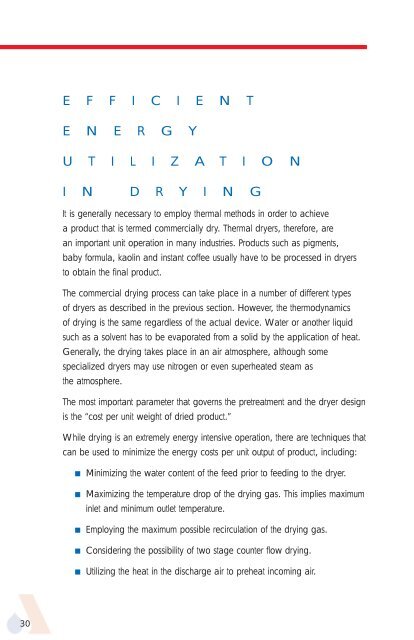APV Dryer Handbook - Umbc
APV Dryer Handbook - Umbc
APV Dryer Handbook - Umbc
You also want an ePaper? Increase the reach of your titles
YUMPU automatically turns print PDFs into web optimized ePapers that Google loves.
30<br />
E F F I C I E N T<br />
E N E R G Y<br />
U T I L I Z A T I O N<br />
I N D R Y I N G<br />
It is generally necessary to employ thermal methods in order to achieve<br />
a product that is termed commercially dry. Thermal dryers, therefore, are<br />
an important unit operation in many industries. Products such as pigments,<br />
baby formula, kaolin and instant coffee usually have to be processed in dryers<br />
to obtain the final product.<br />
The commercial drying process can take place in a number of different types<br />
of dryers as described in the previous section. However, the thermodynamics<br />
of drying is the same regardless of the actual device. Water or another liquid<br />
such as a solvent has to be evaporated from a solid by the application of heat.<br />
Generally, the drying takes place in an air atmosphere, although some<br />
specialized dryers may use nitrogen or even superheated steam as<br />
the atmosphere.<br />
The most important parameter that governs the pretreatment and the dryer design<br />
is the “cost per unit weight of dried product.”<br />
While drying is an extremely energy intensive operation, there are techniques that<br />
can be used to minimize the energy costs per unit output of product, including:<br />
■ Minimizing the water content of the feed prior to feeding to the dryer.<br />
■ Maximizing the temperature drop of the drying gas. This implies maximum<br />
inlet and minimum outlet temperature.<br />
■ Employing the maximum possible recirculation of the drying gas.<br />
■ Considering the possibility of two stage counter flow drying.<br />
■ Utilizing the heat in the discharge air to preheat incoming air.











